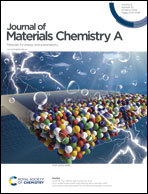Cobalt-based current collectors for flexible electrodes and their application in lithium–sulfur batteries†
Abstract
Flexible energy storage devices with high energy density and excellent mechanical properties have attracted great interest in the development of flexible electrodes. However, flexible electrodes don't have current collectors, limiting their battery performance. To improve the performance of flexible electrodes, a cobalt-based (Co-based) current collector was designed and fabricated. It is proved that the Co-based current collector is promising due to high conductivity, light weight, continuity and close contact with the electrode. Meanwhile, when the Co-based current collector is applied in lithium–sulfur batteries, it can physically and chemically restrict polysulfides and inhibit the shuttle effect. As a result, Li–S batteries assembled with Co modified electrodes deliver a specific discharge capacity of 899 mA h g−1 at 1C. And a high reversible capacity of 639 mA h g−1 and capacity retention of 56.1% can also be achieved at 0.1C even after continuously running for 200 cycles with a high sulfur loading of 8 mg cm−2.

- This article is part of the themed collection: Design and characterization of flexible electrode materials


 Please wait while we load your content...
Please wait while we load your content...